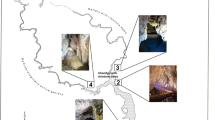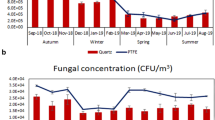Abstract
Bioaerosols in cave air can serve as natural tracers and, together with physical parameters, give a detailed view of conditions in the cave atmosphere and responses to climatic changes. Airborne microbes in the Postojna Cave system indicated very dynamic atmospheric conditions, especially in the transitory seasonal periods between winter and summer. Physical parameters of cave atmosphere explained the highest variance in structure of microbial community in the winter and in the summer. The airborne microbial community is composed of different microbial groups with generally low abundances. At sites with elevated organic input, occasional high concentrations of bacteria and fungi can be expected of up to 1,000 colony-forming units/m3 per individual group. The most abundant group of airborne amoebozoans were the mycetozoans. Along with movements of air masses, airborne algae also travel deep underground. In a cave passage with elevated radon concentration (up to 60 kBq/m3) airborne biota were less abundant; however, the concentration of DNA in the air was comparable to that in other parts of the cave. Due to seasonal natural air inflow, high concentrations of biological and inanimate particles are introduced underground. Sedimentation of airborne allochthonous material might represent an important and continuous source of organic material for cave fauna.








Similar content being viewed by others
References
Stetzenbach LD (1997) Introduction to aerobiology. In: Hurst CJ, Knudsen GR, McInerney MJ, Stetzenbach LD, Walter MV (eds) Manual of environmental microbiology. ASM Press, Washington, D.C., pp 619–628
Buttner MP, Willeke K, Grinshpun SA (1997) Sampling and analysis of airborne microorganisms. In: Hurst CJ, Knudsen GR, McInerney MJ, Stetzenbach LD, Walter MV (eds) Manual of environmental microbiology. ASM Press, Washington, D.C., pp 629–640
Mohr AJ (1997) Fate and transport of microorganisms in air. In: Hurst CJ, Knudsen GR, McInerney MJ, Stetzenbach LD, Walter MV (eds) Manual of environmental microbiology. ASM Press, Washington, D.C., pp 641–650
Badino G (2004) Cave temperatures and global climatic change. Int J Speleol 33:103–114
Eaton RS (1988) Radon reduction: radon and its decay products in indoor air. Science 241:990
Etiope G, Martinelli G (2002) Migration of carrier and trace gases in the geosphere: an overview. Phys Earth Planet In 129:185–204
UNSCEAR (2000) United Nations Scientific Committee on the Effects of Atomic Radiation UNSCEAR 2000 report to the General Assembly, with scientific annexes. United Nations Scientific Committee on the Effects of Atomic Radiation, Vienna, Austria
Linan C, Vadillo I, Carrasco F (2008) Carbon dioxide concentration in air within the Nerja Cave (Malaga, Andalusia, Spain). Int J Speleol 37:99–106
Perrier F, Richon P (2010) Spatiotemporal variation of radon and carbon dioxide concentrations in an underground quarry: coupled processes of natural ventilation, barometric pumping and internal mixing. J Environ Radioactiv 101:279–296
Alteras I (1966) First Romanian isolation of Histoplasma capsulatum from the soil. Dermatol Int 5:69–71
Nagy K, Kávási N, Kovács T, Somlai J (2008) Radon and speleotherapy in Hungary. La Presse Thermale et Climatique 145:219–225
Saiz-Jimenez C, Gonzalez J (2007) Aerobiology and cultural heritage: some reflections and future challenges. Aerobiologia 23:89–90
Crestani G, Anelli F (1939) Ricerche di meteorologia ipogea delle grotte di Postumia. Istituto poligrafico dello stato Libreria, Roma
Gams I (1970) Zračna cirkulacija kot del jamskega okolja (na primeru Postojnske jame). In: Karaman Z, Manaković D (eds) Congrès Yugoslave de Spéléologie Cinquième session. Speleološki soujuz na Jugoslavija, Skopje
Šebela S (1998) Tectonic structure of Postojnska jama cave system. ZRC Publishing, Ljubljana
Vaupotič J, Ančik M, Škofljanec M, Kobal I (1992) Alpha scintillation cell for direct measurement of indoor radon. J Environ Sci Heal A 27:1535–1540
Warren A, Day JG, Brown S (1997) Cultivation of algae and protozoa. In: Hurst CJ, Knudsen GR, McInerney MJ, Stetzenbach LD, Walter MV (eds) Manual of environmental microbiology. ASM Press, Washington, D.C
Feller W (1950) An introduction to the probability theory and its application. John Wiley and Sons, New York
Visvesvara GS, Moura H, Schuster FL (2007) Pathogenic and opportunistic free-living amoebae: Acanthamoeba spp., Balamuthia mandrillaris, Naegleria fowleri, and Sappinia diploidea. FEMS Immunol Med Microbiol 50:1–26
Page FC (1991) Naked rhizopods [Nackte Rhizopoda]. Gustav Fischer, Stuttgart, New York
Schroeder J, Booton G, Hay J, Niszl I, Seal D, Markus M, Fuerst P, Byers T (2001) Use of subgenic 18S ribosomal DNA PCR and sequencing for genus and genotype identification of acanthamoebae from humans with keratitis and from sewage sludge. J Clin Microbiol 39:1903–1911
Walochnik J, Michel R, Aspöck H (2004) A molecular biological approach to the phylogenetic position of the genus Hyperamoeba. J Eukaryot Microbiol 51:433–440
Adl SM, Simpson AG, Farmer MA, Andersen RA, Anderson OR, Barta JR, Bowser SS, Brugerolle G, Fensome RA, Fredericq S, James TY, Karpov S, Kugrens P, Krug J, Lane CE, Lewis LA, Lodge J, Lynn DH, Mann DG, McCourt RM, Mendoza L, Moestrup O, Mozley-Standridge SE, Nerad TA, Shearer CA, Smirnov AV, Spiegel FW, Taylor MF (2005) The new higher level classification of eukaryotes with emphasis on the taxonomy of protists. J Eukaryot Microbiol 52:399–451
Thompson J, Gibson T, Plewniak F, Jeanmougin F, Higgins D (1997) The CLUSTAL_X windows interface: flexible strategies for multiple sequence alignment aided by quality analysis tools. Nucleic Acids Res 25:4876–4882
Nicholas KB, Nicholas HBJ, Deerfield DWI (1997) Analysis and visualization of genetic variation. Embnew News 4:14
Gast R, Ledee D, Fuerst P, Byers T (1996) Subgenus systematics of Acanthamoeba: four nuclear 18S rDNA sequence types. J Eukaryot Microbiol 43:498–504
Neidhardt FC, Umbarger HE (1996) Chemical composition of Escherichia coli. In: Neidhardt FC, Curtiss R III, Ingraham JL, Lin ECC, Low KB, Magasanik B, Reznikoff WS, Riley M, Schaechter M, Umbarger HE (eds) Escherichia coli and Salmonella: cellular and molecular biology. ASM Press, Washington, D.C., pp 13–16
Schnürer J (1993) Comparison of methods for estimating the biomass of three food-borne fungi with different growth patterns. Appl Environ Microbiol 59:552–555
Chimiklis PE, Karlander EP (1973) Light and calcium interactions in Chlorella inhibited by sodium chloride. Plant Physiol 51:48–56
ter Braak CJF, Šmilauer PI, NY, USA: Microcomputer Power (2002) CANOCO reference manual and CanoDraw fo Windows user’s guide: software for Canonical Community Ordination (version 4.5). Microcomputer Power, Ithaca
Gregorič A, Zidanšek A, Vaupotič J (2011) Dependence of radon levels in Postojna Cave on outside air temperature. Nat Hazards Earth Syst Sci 11:1523–1528
Vaupotič J, Csige I, Radolić V, Hunyadi I, Planinić J, Kobal I (2001) Methodology of radon monitoring and dose estimates in Postojna Cave, Slovenia. Health Phys 80:142–147
Docampo S, Trigo MM, Recio M, Melgar M, García-Sánchez J, Cabezudo B (2011) Fungal spore content of the atmosphere of the Cave of Nerja (southern Spain): diversity and origin. Sci Total Environ 409:835–843
Binnie PWH (1991) Biological pollutants in the indoor environment. In: Kay JG, GE Keller, Miller JF (eds) Indoor air pollution, radon, bioaerosols, & VOC’s, vol 1. Lewis Publishers, Chelsea, pp 13–24
Robertson LD (1997) Monitoring viable fungal and bacterial bioaerosol concentrations to identify acceptable levels for common indoor environments. Indoor Built Environ 6:295–300
Walochnik J, Mulec J (2009) Free-living amoebae in carbonate precipitating microhabitats of karst caves and a new vahlkampfiid amoeba, Allovahlkampfia spelaea gen. nov., sp nov. Acta Protozoologica 48:25–33
Kinnear FB (2003) Cytopathogenicity of acanthamoeba, vahlkampfia and hartmannella: quantative & qualitative in vitro studies on keratocytes. J Infect 46:228–237
Lorenzo-Morales J, Martínez-Carretero E, Batista N, Alvarez-Marín J, Bahaya Y, Walochnik J, Valladares B (2007) Early diagnosis of amoebic keratitis due to a mixed infection with Acanthamoeba and Hartmannella. Parasitol Res 102:167–169
Molmeret M, Horn M, Wagner M, Santic M, Abu Kwaik Y (2005) Amoebae as training grounds for intracellular bacterial pathogens. Appl Environ Microbiol 71:20–28
Ramette A (2007) Multivariate analyses in microbial ecology. FEMS Microbiol Ecol 62:142–160
Šebela S, Turk J (2011) Local characteristic of Postojna Cave climate, air temperature, and pressure monitoring. Theor Appl Climatol 105:371–386
Pagelkopf P, Porstendorfer J (2003) Neutralisation rate and the fraction of the positive Po-218-clusters in air. Atmos Environ 37:1057–1064
Lieser KH (2001) Dosimetry and radiation protection. Wiley-VCH, Berlin, pp 417–436
Anitori R, Trott C, Saul D, Bergquist P, Walter M (2002) A culture-independent survey of the bacterial community in a radon hot spring. Astrobiology 2:255–270
Darby S, Hill D, Doll R (2001) Radon: a likely carcinogen at all exposures. Ann Oncol 12:1341–1351
Boening DW (2000) Ecological effects, transport, and fate of mercury: a general review. Chemosphere 40:1335–1351
Sket B (1999) High biodiversity in hypogean waters and its endangerment—the situation in Slovenia, the Dinaric Karst, and Europe. Crustaceana 72:767–779
Acknowledgments
This study was supported by the bilateral research project “Study of amoebal viability and vehicle of their transport in the environment: case study from karst caves” (BI-AT/09-10-023) and program Karst Research P6-0119 funded by the Slovenian Research Agency. Authors are especially grateful to Andrej Mihevc, Franjo Drole, and Stanislav Glažar for assistance in locating representative sampling sites for the study; to Andreea Oarga for help during field work; to Jacek Pietrzak (Medical University of Vienna) for excellent technical assistance; and to Franko Radošič (Institute of Occupational Safety), Andrej Kozinc (Merck d.o.o., Slovenia), and Karmen Stanič (National Institute of Biology) for facility support. Useful comments on an earlier version of the manuscript were provided by Andrej Mihevc, Stanka Šebela, and Ivan Kobal. We thank Elizabeth D. Covington for terminology assistance.
Author information
Authors and Affiliations
Corresponding author
Rights and permissions
About this article
Cite this article
Mulec, J., Vaupotič, J. & Walochnik, J. Prokaryotic and Eukaryotic Airborne Microorganisms as Tracers of Microclimatic Changes in the Underground (Postojna Cave, Slovenia). Microb Ecol 64, 654–667 (2012). https://doi.org/10.1007/s00248-012-0059-1
Received:
Accepted:
Published:
Issue Date:
DOI: https://doi.org/10.1007/s00248-012-0059-1




